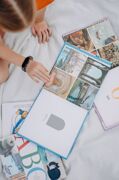- Home
- Parents
- Reading and Phonics
Reading and Phonics
Reading and Phonics
One of the most important things your child learns in school is how to read.
How can you help?
You can help your child understand that the world is full of things to read and that reading happens all the time. When you and your child are shopping or crossing a street, look at the signs – talk about what they say and mean.
At home or on the street, point out newspapers, magazines, letters, and packaged goods. Draw your child’s attention to the words in advertisements, directions, recipes, and bills. Visit a library or bookshop and find books about everything imaginable – history, cooking, religion, art, literature and much more.
Look at books together with your child at home. Find a quiet place and make it a special time. Have your child read aloud to you: observe the pictures, recall the story together and share the wonders and enjoyment of a good book.
Don’t forget to ask children questions about what they have read to probe and develop their understanding. The three resources below will support with question stems as a good starting point!
Reading Vipers Question Stems KS1
Reading Vipers Question Stems KS2
You can make literacy a party of your child’s life in other ways too. You and your child might recite poems, retell folktales, explore legends and myths. You might work on puzzles, play games, or use a cookbook together.
All of these things will help your child become a reader. Children who read do better in school; they acquire skills that they will need throughout their lives. Reading is an important part of a child’s heritage.
 School Reading Spine
School Reading Spine
We have devised a school reading spine (which includes recommendations from Pie Corbett’s reading spine) as part of our daily reading offer to children.
Our reading spine is a core collection of books that we want all children in our school to experience and enjoy. These include wordless books, classics and other essential reads that designed to not only foster a love of reading but offer children a broad range of book experiences.
Our reading spine can viewed here:
Read, Write, Inc Information and Guidance
To teach our children to read, we use Read, Write, Inc which is an inclusive systematic synthetic phonic programme in EYFS, Year 1 and Year 2. We have adopted this as our whole school approach as the programme facilitates a graduated and tailored approach to learning basic sounds and letter formation before advancing to more complex sounds and reading for comprehension. The programme moves with integrity from learning to read to reading to learn.
RWInc sessions occur each day as the continuity and pace of the programme is key to accelerating the progress of children’s reading development. This method of phonics works teaching is both systematic and repetitive in order to embed learning. The children work in groups according to their confidence and competence. These groups are reconfigured on a regular basis in order to match the pace and the progress of each child; this reconfiguration also allows Class Teachers and the Phonics Leader to identify where 1:1 intervention may be required in order to meet the expectations of both the Phonics Check and the end of Key Stage 1.
Within all the books children will have Red and Green words to learn in order to help them to become speedy readers.
Red words are words that are not easily decodable and challenge words to extend children’s vocabulary.
Green words are linked to the sounds that they have been learning and are easily decodable.
For further information please visit the Read Write Inc website as well as clicking on the information below.
Red Words – those 'need to learn' ones!
Accelerated Reader
Once children have completed the RWInc Phonics scheme, they will be able to choose banded books from our library. As the selection of books in the library is broad, we use some software called Accelerated Reader (AR) to help scaffold book match to ensure that children are reading books that are challenging but accessible. The parent/carer guide below provides key information about AR for parents and carers. If you have any questions reading it, please don’t hesitate to contact your child’s class teacher.